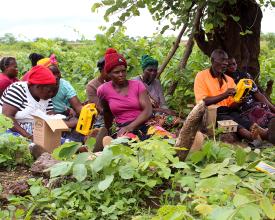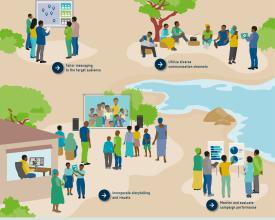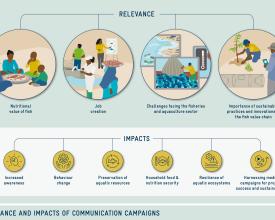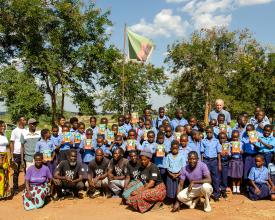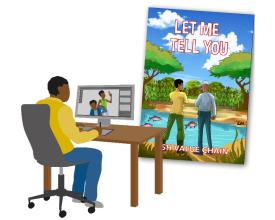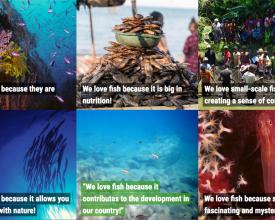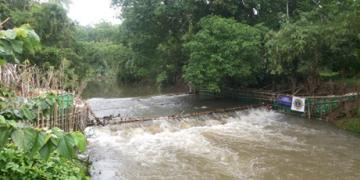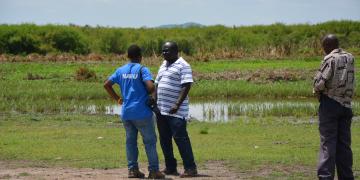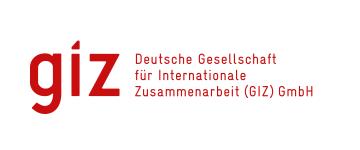
Communication campaigns for sustainable fisheries and aquaculture
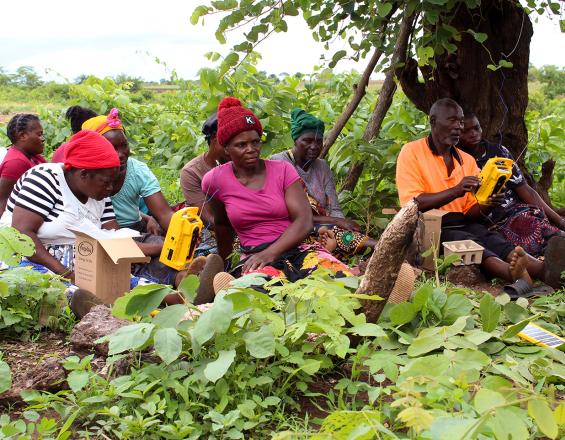
The Global Programme Sustainable Fisheries and Aquaculture, implemented by the Deutsche Gesellschaft für Internationale Zusammenarbeit (GIZ) on behalf of the German Federal Ministry for Economic Cooperation and Development, aims to increase the fish supply from sustainable and resource-friendly fisheries and aquaculture to boost a healthy nutrition and support sustainable livelihoods. Sustainable production and processing techniques are promoted along the value chain in order to create jobs and income.
Effective communication strategies play a vital role in achieving these objectives and in advancing sustainability goals in the fisheries and aquaculture sector. This solution gives insights into the preparation and implementation of communication campaigns to raise awareness on sustainable fisheries and aquaculture along the fish value chain, including practical examples and impacts of such campaigns.
Contexte
Challenges addressed
Fish plays a crucial role in supporting the livelihoods of millions of people. Various countries worldwide are home to diverse aquatic resources, including freshwater lakes, rivers, and coastal waters, which support a wide array of fish species and provide ideal conditions for aquaculture activities. The abundance of aquatic resources in these regions significantly contributes to community livelihoods, food and nutrition security, and economic growth.
But overfishing, habitat destruction, pollution, climate change, illegal fishing practices, and inadequate management and regulation often lead to negative impacts on biodiversity and food and nutrition security. Despite these challenges, the fisheries and aquaculture sector have the potential for sustainable growth and development through effective communication strategies.
Emplacement
Traiter
Summary of the process
Communication campaigns contribute to the preservation of aquatic resources, the well-being of surrounding communities, and the resilience of aquatic ecosystems. In this context, this document highlights how some media campaigns within the Global Programme Sustainable Fisheries and Aquaculture were developed and conducted.
The following building blocks share insights into fundamentel steps of the approach for conducting successfull media campaigns: From the objectives of communication campaigns, to tailoring messages to target groups, utilizing diverse communication channels, incorporating storytelling and visuals, and monitoring and evaluating campaign performances.
Building Blocks
Objectives of Communication Campaigns
Communication campaigns play a vital role in advancing sustainability goals in these sectors. These campaigns educate various stakeholders in the fish value chain, including fishers, fish farmers, retailers, consumers, policymakers, and the general public, about the importance of sustainable practices and the nutritional value of fish. A communication campaign can effectively communicate the value of fish in nutrition, the potential of the fisheries and aquaculture sector to create jobs and income, the challenges facing the industry, and the importance of sustainable practices and innovations. By highlighting these key points, the campaign can foster collaboration among stakeholders in the sector to address common challenges and work towards shared goals. This collaboration can lead to the building of partnerships between government agencies, industry players, non-profit organisations, and other relevant stakeholders to promote sustainable practices, support innovation, and drive economic growth in the fisheries and aquaculture sector. Through communication campaigns, stakeholders can be mobilized to participate in training programmes aimed at improving skills, knowledge, and practices in the industry. These campaigns can also mobilize support for initiatives that promote sustainable fisheries management, conservation efforts, and responsible aquaculture practices. By engaging with stakeholders and raising awareness about the importance of these initiatives, communication campaigns can encourage behaviour change in both production and consumption patterns, leading to more sustainable practices and a healthier marine ecosystem.
Tailor messaging to the target audience
When creating a communications campaign about fisheries and aquaculture, it is essential to tailor the messaging to the target audience to ensure maximum impact and engagement. Consider the specific demographics, interests, and knowledge levels of the audience you are trying to reach. Understanding the target audience and traditions surrounding the perception, practices, and consumption of fish, can help in crafting messages that are relatable and impactful. Adapting the messages to the cultural context is also crucial when planning a media campaign, because it ensures that the content resonates with the target audience in a meaningful way.
The “Let Me Tell You” series animations, focusing on the nutrition value of fish, sustainable aquaculture practices, the fish value chain, and WASH elements, is particularly suitable for the rural Zambian context for several reasons. Firstly, the use of animations can effectively convey complex information in a visually engaging and easily understandable format, making it accessible to a wide audience, including those with low literacy levels.
Secondly, targeting school kids with this animation series is a strategic approach to start early sensitization on the importance of fish and the potential of the fisheries and aquaculture sector. By educating children about these topics, they can become advocates for sustainable practices within their families and communities, helping to instill a culture of responsible consumption and environmental stewardship from a young age. Additionally, animations have the ability to capture the attention and interest of children, making the learning process more enjoyable and memorable. This can lead to increased retention of information and a greater likelihood of behaviour change towards more sustainable practices related to fish consumption and the fisheries sector. While the animation is inspired by Zambia’s rural landscape and its communities’ culture and traditions, the series still resonates with other countries in the Southern African region.
Cultural context influences how individuals perceive and interpret messages. Adapting the messaging to align with cultural norms, values, beliefs, and language can enhance the effectiveness of the campaign. By considering these factors, the campaign can avoid misunderstandings, misinterpretations, or unintended offense. This also demonstrates respect for the diversity and uniqueness of different communities, fostering a sense of inclusivity and connection with the audience.
Tailoring communication channels to the target audience: utilizing traditional and digital media
The various communication and media channels that exist are used differently by different audiences. To effectively reach and engage with a wider audience, traditional media channels, such as television, radio, and print, have a broad outreach and can help in attracting a more diverse demographic. On the other hand, digital media channels, including social media, websites, and online platforms, offer the advantage of interactivity, real-time communication, and targeted messaging.
However, most remote or rural audiences with limited internet connectivity or no access to smart gadgets may not be reached effectively. Both traditional and digital media channels were evaluated to explore their strengths and weaknesses. Traditional media channels can help in building brand awareness and reaching a mass audience, while digital media channels can provide more personalized and targeted communication to audiences that have access to digital gadgets and internet connection. Content created to raise awareness about fish such as the communication product “24 reasons to love fish” can be uploaded on social media for real time accessibility. Both traditional and digital media channels were utilized in the media campaigns of the Global Programme Sustainable Fisheries and Aquaculture.
The “7 Outna” (Our Fish) campaign aimed to promote the small-scale fisheries sector and the consumption of small pelagic fish in Mauritania by addressing various aspects such as nutrition, accessibility, affordability, and positive societal impacts. Both the “7 Outna” campaign and the “Let Me Tell You” series made use of TV, radio and print media to reach a wide audience.
Collaborating with key stakeholders
Collaborating with key stakeholders such as fishers, fish farmers, government agencies, project implementing partners, and local communities can enhance the credibility and outreach of the campaign. Involving these stakeholders in the planning and implementation process of a media campaign on fisheries and aquaculture is crucial for gathering support and ensuring the sustainability of the initiatives by spreading them more widely beyond the project duration. This can be done by identifying the necessary stakeholders for a media campaign on fisheries and aquaculture and requesting input on concepts, Terms of Reference, or script content for the campaign. This can help ensure that the messaging is accurate, relevant, and resonates with the target audience. Establishing feedback loops during the campaign development process allows for continuous input and adjustments based on stakeholder feedback, leading to a more refined and successful campaign. Involving stakeholders in the planning and implementation of the media campaign not only ensures quality control of the campaign material but can also increase buy-in and support for the initiative. This collaborative approach fosters a sense of ownership among stakeholders, enhances the credibility of the campaign, and ultimately contributes to the long-term sustainability and success of the fisheries and aquaculture initiatives being promoted. Furthermore, working with key stakeholders can help identify potential challenges or opportunities that may not have been apparent initially, leading to more informed decision-making and strategic planning. Engaging stakeholders also leverage their networks and resources to amplify the reach and impact of the media campaigns.
Incorporating storytelling and visuals
Incorporating storytelling and visuals is essential for effective communication and engagement with the target audience. Combining storytelling and visuals in a media campaign on sustainable fisheries and aquaculture can help increase awareness, educate stakeholders, and inspire action towards sustainable practices. For instance, a visual representation of depletion of fish in a dam can help building a connection between the audience and the cause, fostering a sense of understanding for the importance of preserving aquatic resources and promoting responsible practices in the industry.
By presenting information in a compelling and relatable way, it can evoke emotions, capture attention, and make complex concepts easier to understand. Visuals, such as images, videos, and infographics, enhance the storytelling experience by providing a visual representation of the information being conveyed in a specific context. Visuals can help to reinforce key messages, increase retention of information, and appeal to different learning styles.
Overall, clear objectives and target audience identification, strategic planning and message development, effective use of various media channels, consistent messaging and branding, monitoring and evaluation of campaign performance, and adaptability to feedback and changing circumstances are important for communication purposes. Additionally, collaboration with stakeholders, understanding of audience preferences and behaviours, and creativity in content creation are essential for the success of media campaigns.
Impacts
Media campaigns
- raise awareness among various stakeholders about the importance of sustainable practices in the fisheries and aquaculture sector and raise the profile of small-scale fisheries. They also promote awareness for the nutritional value of fish in human consumption.
- promote responsible practices and highlight the benefits of sustainable fisheries and aquaculture as well as encourage behaviour change among fishers, fish farmers, consumers, policymakers, and the general public. Increased knowledge on risks associated with unsustainable practices such as the use of illegal fishing gear further support these efforts.
- contribute to the preservation of aquatic resources through education and awareness by promoting sustainable practices that help maintain the health and biodiversity of aquatic ecosystems and bring light to blue economy in general.
- emphasize the importance of sustainable practices and the nutritional value of fish. They contribute to the well-being of surrounding communities that rely on fisheries and aquaculture for their livelihoods and food and nutrition security, including the shared knowledge on creation of income from fish.
- enhance building of resilience in aquatic ecosystems by promoting practices that reduce negative impacts such as overfishing, habitat destruction, and pollution, thus ensuring the long-term health and sustainability of these ecosystems.
Beneficiaries
Behaviour change contributes to responsible practices, sustainable livelihoods, long-lasting income possibilities and improved food and nutrition security for fish farmers and consumers.
Preservation of aquatic resources and resilience in aquatic ecosystems.
Sustainable Development Goals
Story
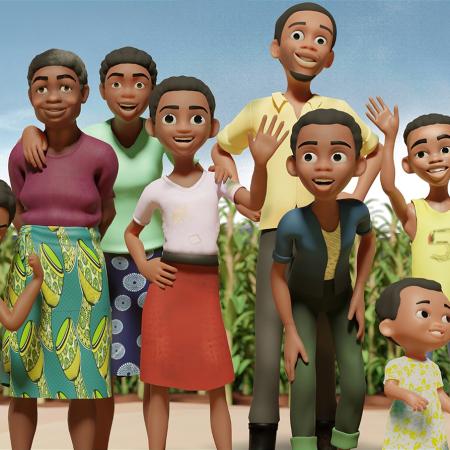
The “Let Me Tell You” series was developed in Zambia to raise awareness about the nutritional value of fish and educate on sustainable fishing practices. The series was specifically created for Zambian populations facing food insecurity, dam management committees, actors in the fish value chain, fishing communities in Eastern and Luapula provinces, and the general Zambian public. The series consists of short, animated films, comic booklets, and recorded radio shows covering topics on nutrition, sustainable aquaculture, and gender-transformative approaches in the fish value chain and fisheries management. This animation series, Zambia’s first on nutrition, was a collaborative effort between the GIZ Fish for Food Security (F4F) project, the Food and Nutrition Security Enhanced Resilience (FANSER) project, the Ministry of Fisheries and Livestock (MFL), and the National Food and Nutrition Commission (NFNC).
The goal of the “Let Me Tell You” campaign is to contribute to national nutrition awareness efforts. The series consists of eight episodes covering topics like protein, Omega 3 fatty acids, aquaculture, fish value chain, Vitamin A, handwashing, introduction to the body, and iron. All episodes are translated into English, Bemba, and Nyanja to ensure accessibility for a wider audience in Zambia. Community sensitizations through roadshows have been conducted to further disseminate the messages from the series. The “Let Me Tell You” series has effectively utilized mass communication tools to reach target audiences in Zambia, particularly in Luapula and Eastern provinces, with culturally appropriate content. In addition to promoting the nutritional benefits of fish, the campaign also focuses on educating about sustainable fishing practices to combat illegal fishing activities, promote natural resource management, and address environmental issues like water quality, pollution, waste management, and erosion.


